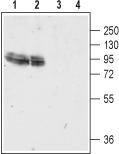Gria4 Rabbit Polyclonal Antibody
Other products for "Gria4"
Specifications
| Product Data | |
| Applications | IHC, WB |
| Recommended Dilution | WB: 1:200-1:2000; IHC: 1:100-1:3000 |
| Reactivities | Human, Mouse, Rat |
| Host | Rabbit |
| Clonality | Polyclonal |
| Immunogen | Peptide (C)KLMDRWKKLDQRE, corresponding to amino acid residues 274-286 of rat AMPA Receptor 4. Extracellular, N-terminus. |
| Formulation | Lyophilized. Concentration before lyophilization ~0.8mg/ml (lot dependent, please refer to CoA along with shipment for actual concentration). Buffer before lyophilization: Phosphate buffered saline (PBS), pH 7.4, 1% BSA, 0.025% NaN3. |
| Purification | Affinity purified on immobilized antigen. |
| Conjugation | Unconjugated |
| Storage | Store at -20°C as received. |
| Stability | Stable for 12 months from date of receipt. |
| Gene Name | glutamate ionotropic receptor AMPA type subunit 4 |
| Database Link | |
| Background | Glutamate is the major excitatory neurotransmitter and modulates its effects via ionotropic and metabotropic receptors which are different in their molecular, biochemical, pharmacological and physiological properties. The ionotropic ligand-gated ion channel glutamate receptors are classified into three major subtypes, AMPA, kainate and NMDA receptors according to their selective agonist. AMPA receptors consist of four closely related genes with about 70% homology that encode the four subunits GluR1-4. Their expression is known to be developmentally regulated and are also known to undergo alternative splicing. In fact, all four receptors have two splice variants, termed flip and flop, in an extracellular region adjacent to the M4 transmembrane region. These splice variants are also developmentally regulated such that flip is expressed before birth and remains highly expressed throughout adulthood whereas flop expression is postnatal and reaches flip’s level in adulthood. In addition to their expression regulation, flip and flop also differ in their activation/inactivation kinetics. Each AMPA receptor contains 3 membrane spanning domains (M1, M3 and M4), while the fourth hydrophobic domain (M2) is a reentering cytoplasmic loop that forms part of the channels pore. Different stoichiometries of these receptors form tetrameric structures to eventually form functional receptors. AMPA receptors are highly expressed in the brain. However, the GluR4 subunit is present in lower amounts in the CNS, except in the reticular thalamic neuclei and the cerebellum. The primary depolarization in glutamate neurotransmission is mediated by AMPA receptors, which are also key players in synaptic plasticity, learning and memory formation. The cellular distribution and post-translational modifications like phosphorylation are important for the activity of AMPA receptors and are thought to play a role in the long lasting and activity-dependent changes in synaptic strength. |
| Synonyms | GluA4; Glur-4; GluR-D; GluR4; Glur4; Gluralpha4; spkw1 |
| Reference Data | |
Documents
| Product Manuals |
| FAQs |
{0} Product Review(s)
0 Product Review(s)
Submit review
Be the first one to submit a review
Product Citations
*Delivery time may vary from web posted schedule. Occasional delays may occur due to unforeseen
complexities in the preparation of your product. International customers may expect an additional 1-2 weeks
in shipping.






























































































































































































































































 Germany
Germany
 Japan
Japan
 United Kingdom
United Kingdom
 China
China




